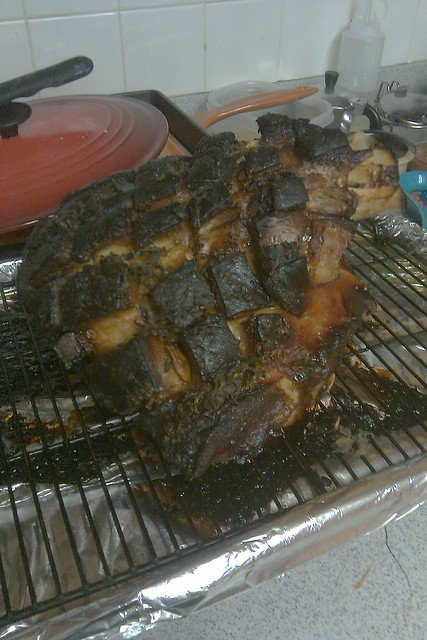
Check it out! I'm actually posting a recipe before Jonathan did from last week's show! Although calling this a recipe is really stretching the definition of recipe--the dish is more about technique than ingredients or measurements.
July 6 was What's Cookin' Now's two-year anniversary, and we decided to go Back to the Grill to commemorate our very first show together, when we performed what J called "the ultimate in stunt-grilling"--grilled pizzas. For this show, I wanted to do something summery and delicious, and we've been rocking variations on grilled salads in Sisterville all summer, so I decided to make one of those. I wrestled my battered Weber into the back of my car (the legs fell off, facilitating the wrestling and allowing me to win the match), loaded up my produce into a cooler, and headed for WMMT.
While Jonathan fired up the grill on the back deck (charcoal, newspaper, and a chimney starter eliminate the need for spraying the coals with nasty-tasting petroleum products), I prepped my vegetables. I had an eggplant, some yellow crookneck squash, zucchini, a red onion, some pretty red and yellow and orange bell peppers, and of course, some romaine lettuce. I was going for color and flavor--but you could put anything you want on this salad. I made it again a few nights later and added asparagus.
If you're going to grill eggplant, you need to salt it first to draw out the water so it will retain its shape. I cut mine longways into planks, about a half-inch thick, then sprinkled them liberally with kosher salt and layered them in a colander to drain. This really needs to be done about an hour before you grill, although I fudged and only had about a half hour, and mine came out okay. I cut the squash and zucchini into long planks, too, and sliced the onion into half-inch slices. I cut the peppers in half, removed the seeds and stems, and smashed them flat. I wanted everything big enough to not fall through the grate--you can always cut things up after you grill them.
The easiest way to do this is to throw everything (except the onion--it'll fall apart) into a big bowl and drizzle it with olive oil, then lay it on a hot oiled grill (use a grill brush to clean the grate, and a paper towel dipped in oil and held with tongs to oil the grill), sprinkle with salt (I like to use Goya Adobo), and grill until you get some char on the edges. At that point, if the vegetables aren't tender enough for you, you can lay them on the cooler side of the grill, or wrap them loosely in foil, where they'll steam a bit and soften.
While you're grilling the vegetables, you can make the dressing. Mash one or two anchovies (and if you think you don't like anchovies, please, just try this--they're delicious) and a few cloves of garlic (I think I used three) together with about four tablespoons of olive oil. An immersion blender makes quick work of this and produces a nice creamy dressing. Add the juice of one lemon. Place an egg, in the shell, on the grill for about four minutes, turning it with tongs halfway through. This will coddle the egg--since it won't be cooked through, you may want to use a pasteurized egg. Break the egg into the dressing and blend it until it emulsifies.
Now char the lettuce. If you're serving this with a nice steak, a good time to do this is while the meat rests after it comes off the grill. Cut the romaine heads lengthwise into halves or quarters, depending on how big it is. You want a nice flat surface to char. Brush the lettuce with olive oil. This should be done over fairly high heat, since you want to char the lettuce quickly--it will wilt a bit, but should remain crunchy. Turn it with tongs to char both sides. Remove the lettuce to a large platter, top with the chopped, grilled vegetables, and drizzle with the dressing. Oh, and croutons are nice here--I used some ciabatta rolls, cut into cubes and skewered, then brushed with olive oil, sprinkled with salt and grilled a bit until they were crunchy.
As is the case with most salads, there are endless variations on this recipe. Add potatoes and sliced steak, or garbanzo beans and parmesan cheese. Use only the small inner cores of the lettuce and make little individual salads. Add some herbs to the dressing--it's your call. Happy grilling!





